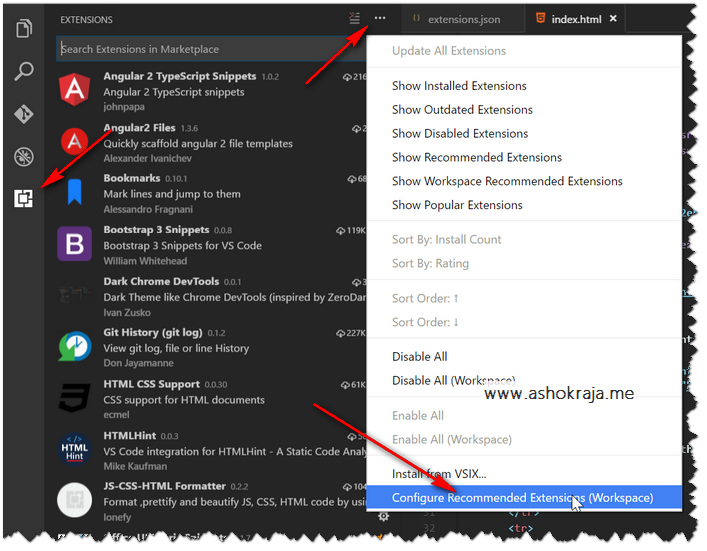Copy files from the starter Angular app into the folder containing the.csproj file. Include the files in the Visual Studio project as follows: Click the Show All Files button in Solution Explorer to reveal all of the hidden files in the project. Right-click on each folder/file to. Use the Angular project template with ASP.NET Core Create a new app. If you have ASP.NET Core 2.1 installed, there's no need to install the Angular project template. Add pages, images, styles, modules, etc. The ClientApp directory contains a standard Angular CLI app. See the official. Getting started in Visual Studio Team Services (VSTS) eventually leads to planning a sprint. This post discusses how to configure a sprint in VSTS and schedule work for this iteration. This is one of a series of posts detailing the process of building an application with Angular, Visual Studio. Angular CLI - Visual Studio Marketplace Angular CLI Task and Template for Azure Pipelines The extension provides the basic tasks for building Angular applications using.
- Angular In Visual Studio 2012
- Setup Angular In Visual Studio Code
- Run Angular From Visual Studio
- Visual Studio Angular 10

Angular 8.0 is out and so Visual Studio 2019 with .NET Core 3.0. With the recent preview release of .NET Core 3.0, the Angular SPA template for ASP.NET Core 3.0 has now been updated to use Angular 8. So you no longer have to install any third-party templates to create an Angular 8 based app. This post talks about how to create an Angular 8 App with Visual Studio 2019.
If you want to learn all of Angular, I want to personally recommend ng-book as the single-best resource out there. You can get a copy here. The book is updated to Angular 8.
In this post, we’ll use an ASP.NET Core 3.0 based Angular template project, which out of the box creates an Angular 8 app.
Before we create the application, first we need to install Visual Studio 2019 and .NET Core 3.0. Let’s first install .NET Core 3.0 SDK.
Installing .NET Core 3.0
Angular In Visual Studio 2012
To download .NET Core 3.0 preview, visit this link. Based on your platform, download the appropriate installer(if you have already installed, then please update to the latest version). Once the download is complete, run the installer to install .NET Core 3.0 on your system. The .NET Core 3.0 preview installation will not impact your existing .NET Core version installation.
Installing Visual Studio 2019 Preview
To install Visual Studio 2019 preview, download the installer from this location. Don’t worry. Visual Studio and Visual Studio “Preview” can be installed side-by-side on the same device. It will have no impact on your current stable VS installation.
Visual Studio 2019 offers a completely new project creation experience. You can read more about the new experience here. Once the installation is complete, let’s open the Visual Studio 2019 preview and create the ASP.NET Core 3.0 app. Select the ASP.NET Core Web Application template.
You will also need to install the latest version of Node.js, npm and Angular CLI. If you have already installed node then please update it to the latest version.
Now, open the Visual Studio 2019 preview and create the ASP.NET Core 3.0 app. Select the ASP.NET Core Web Application template. When you click Ok, you will get the following prompt. Select ASP.NET Core 3.0 (make sure ASP.NET Core 3.0 is selected) and choose the Angular template.
Setup Angular In Visual Studio Code
If you don’t see ASP.NET Core 3.0 in the dropdown, you can try these fixes provides in here and here. However, in my case, nothing worked. So to fix it, I uninstalled the VS 2019 and installed the latest version again. After successful installation, I was able to see ASP.NET Core 3.0 in the framework selection dropdown.
From the template selection dialog box, select Angular and hit OK. Visual Studio will take a few seconds to create the Angular application. Once the application is created, you can verify the angular version in the package.json file which is placed inside the ClientApp folder.
Run Angular From Visual Studio
Now, just build the application and run it. You might get the following error (Such errors are expected as things are still in preview mode).
To fix this issue, open command prompt and navigate to the ClientApp folder. Now, execute ng build command once to build the application. After it is built successfully, come back to Visual Studio and run the app once again. This time you should see Angular 8 app running successfully in the browser.
Ideally, in development mode, there’s no need to run ng serve. It runs in the background automatically, so your client-side resources are dynamically built on demand and the page refreshes when you modify any file. The code is already in place in the Startup.cs file.
Since it’s still in preview, so this will be fixed when the final version comes out.

If you really want to master Angular 8, ng-book is the single-best resource out there. Get your copy here at 20% discount.
Thank you for reading. Keep visiting this blog and share this in your network. Please put your thoughts and feedback in the comments section.
Visual Studio Angular 10
